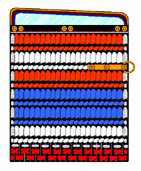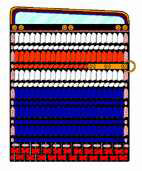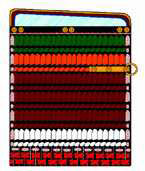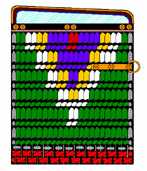Chapter Five:
Odoshi Lacing Patterns
Pattern lacing really only works with kebiki odoshi. Sugake odoshi does not, as a rule, vary in shades or patterns, and at any rate at no account should the two braids in sugake odoshi alternate colors, as I have seen in one or two SCA armours.
The following lacing patterns also hold with braid as well as leather, although of course common sense and aesthetics should be a guide.
Although some shades of lacing are used independently (like hanada, a pale blue), many hues seem to exist primarily to provide the varigated shade patterns used in nioi odoshi and susogu odoshi. In these lacing patterns, the colors go in even steps from white to rich and dark. For nioi odoshi, the darkest band of color is at the top; it is at the bottom in susogu odoshi. In earlier armours, the first band is white, then there is a pale-yellow band, and then the lightest shade of the base color first appears. Later armours might eliminate the yellow band and go from white to pale base, then on. There are also rare models where the colors come vertically from the edges (dark) to the middle (white).
Kon susogu (dark blue fading up to white)
Moegi nioi (dark green fading down to white)
Murasaki hata nioi (purple extremeties fading to white center)
Katadori is a term applied to an armour in which there is a difference in color toward the top of the armour. When it’s an injected band or two toward the top, it’s called [base color] katadori [interjected color], and when it’s actually the top band or two that is a different color than the body rest of the armour, it’s called [base color] wata [new color]. For example, when the top color is white, it is called wata shiro. Aka wata shiro (a red armour with a white band at the top) was fairly common. The reverse, with the odd color on the bottom, was called koshidori.
Aka wata shiro (red with a white top)
Hanada katadori murasaki (pale blude with a purple band toward the top)
Kuro wata aka (black with a red top)
Moegi koshidori hi ito (green with orange on the bottom)
Iro-iro odoshi has no set patterns; the lacing alternates colors in a random pattern. There may be as few as three, and as many as six different colors.
Four examples of iroiro odoshi.
Not to be confused with iroiro odoshi is a pattern of two alternating colors called dan odoshi (lit. “step lacing”). When a second color isn’t specified, it’s usually white.
Kurenai dan odoshi (red alternating white)
One of the most exotic patterns is omodaka odoshi, which is named for the water plantain, the leaves of which the pattern is said to resemble. In this pattern, a large triangle is built up at the center; two layers of white, then at least two more colors with the innermost color “filling up” the triangle. The base color is the surrounding lacing. An inverted version, saga omodaka odoshi, also exists.
Hi omodaka (orange with an up-pointing triangle)
Moegi sagaomodaka (green with a down-pointing triangle)
A near cousin of omodaka is tsumadori. This pattern resembles nothing so much as an armour with only the edge of the pattern actually on the lacing. This is most commonly seen on ō-yoroi; it seems to have fallen from common use by the 1600s. An inverted pattern was called kata tsumadori.
Hanada tsumadori (pale blue with colored diagonals)
Shiro tsumadori (white with colored diagonals)
Kon kata shiro kata tsumadori aka (blue with a white top with diagonal panel of red)
Mongara odoshi is lacing which reproduces a pattern or a simple picture on the armour. Displayed here are the two most common variations of the mongara; the hinomaru (sun-circle), and the manjū (swastika, a Buddhist symbol).
Kuro aka hinomaru gara (black with a red sun)
Kon aka manjū gara (dark blue with a red swastika)
Another frequent variegated pattern is called shikime. This forms a semblance of a checkerboard, either as an all-over pattern, or a more simple variation of lace producing a sort of cross.
Hanada aka shikime (pale blue with red sections)
Hi murasaki shikime (orange and purple checkerboard)
There are several other exotic patterns shown in armour books, including ones in which colors seem to flow down the armour in waves with the lacing being forced into shapes and patterns. These are usually Edo Era developments and have no place in Period armours. There are extant Period examples (e.g., the tatewae odoshi here), which can be readily identified because the lacing maintains its natural vertical flow regardless of the colors used.
Tatewae odoshi
Patterns used on the front of the dō are repeated on back, on the shikoro and the sode, and often on the kusazuri as well, although sometimes the kusazuri are merely laced in the base color. Some patterns reversed below the waist. That is, on the sode and upper body the lacing went one direction (e.g., the triangles point down) while on the kusazuri it went the other (the triangles pointed up). This was not a universal, however; it was more or less an aspect of the taste of the owner, and the aesthetics of what did and didn’t look good.
Unlike patterns formed by the applications of different colored lacing in adjacent rows or in a specific lacing positions, leather lacing also allows the option of using a lacing material in which the “pattern” is actually printed on the lacing material. The most common patterned leather is kozakura gawa, in which small green or dark blue cherry blossoms are scattered over the pale yellow leather surface. The second most common pattern is shina gawa, in which white “fern leaves” are printed on dark blue or gray leather. It takes considerable skill to do this, as when “properly” done the image of the fern leaves is preserved across the bands of lacing.
There is a startling array of lacing patterns available. I find myself toying with the idea of making an armour using this one…
This page and all contents copyright ©2019 by Sengoku Daimyo, LLC and the authors.
Copying or transmission in all or part without express written permission is forbidden.






















